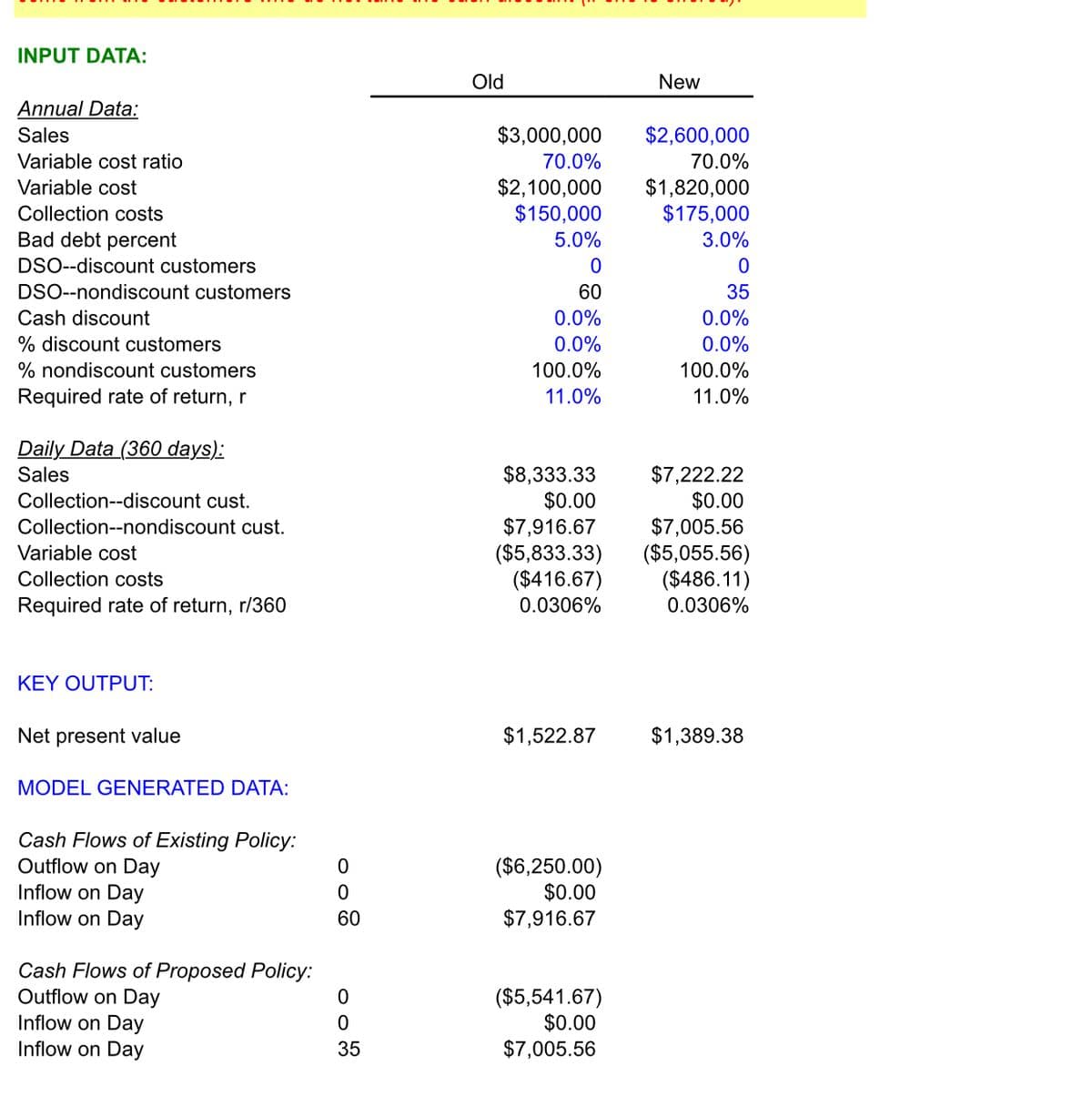Helen Bowers, the new credit manager of the Muscarella Corporation, was alarmed to find that Muscarella sells on credit terms of net 50 days whereas industry-wide credit terms have recently been lowered to net 30 days. On annual credit sales of $3 million, Muscarella currently averages 60 days' sales in accounts receivable. Bowers estimates that tightening the credit terms to 30 days would reduce annual sales to $2.6 million, but accounts receivable would drop to 35 days of sales. She also expects the level of bad debts to decrease from its current level of 5% to 3% with the change in credit terms, because the loss in sales will likely include many customers who are classified as having poorer credit than those who continue to purchase from Muscarella. in addition, collection costs will increase from $150,000 to $175,000 because the collection department will put more effort into collecting delinquent accounts. Muscarella's variable cost ratio is 70% and its marginal tax rate is 40%. (This information is shown on the spreadsheet provided.) Bowers also believes that if she leaves the credit policy as it is, sales will increase to $3.4 million and the DSO-nondiscount customers will remain at 60 days. Bad debts would be 5%. Should Bowers leave the credit policy alone or tighten it as described in either Question 1 or 2? Explain your answer. After comparing the credit policies of other firms, Helen is exploring whether Muscarella should offer a cash discount for early payment. She estimates that if terms of 2/10 net 30 are offered sales will increase to $3.5 million and 15% of the customers wold take the cash discount by paying on Day 10 (DSO-discount customers). The customers who do not take the cash discount are expected to pay on average on Day 50 (DSO-nondiscount customers). Under this policy collection costs would increase to $200,000 and bad debts would decrease to 4.5%. Should Muscarella offer cash discounts under these credit terms? Why or why not?
Bad Debts
At the end of the accounting period, a financial statement is prepared by every company, then at that time while preparing the financial statement, the company determines among its total receivable amount how much portion of receivables is collected by the company during that accounting period.
Accounts Receivable
The word “account receivable” means the payment is yet to be made for the work that is already done. Generally, each and every business sells its goods and services either in cash or in credit. So, when the goods are sold on credit account receivable arise which means the company is going to get the payment from its customer to whom the goods are sold on credit. Usually, the credit period may be for a very short period of time and in some rare cases it takes a year.
Percentages need to be entered in decimal format, for instance 3% would be entered as .03.
Helen Bowers, the new credit manager of the Muscarella Corporation, was alarmed to find that Muscarella sells on credit terms of net 50 days whereas industry-wide credit terms have recently been lowered to net 30 days. On annual credit sales of $3 million, Muscarella currently averages 60 days' sales in accounts receivable. Bowers estimates that tightening the credit terms to 30 days would reduce annual sales to $2.6 million, but accounts receivable would drop to 35 days of sales. She also expects the level of
- Bowers also believes that if she leaves the credit policy as it is, sales will increase to $3.4 million and the DSO-nondiscount customers will remain at 60 days. Bad debts would be 5%. Should Bowers leave the credit policy alone or tighten it as described in either Question 1 or 2? Explain your answer.
- After comparing the credit policies of other firms, Helen is exploring whether Muscarella should offer a cash discount for early payment. She estimates that if terms of 2/10 net 30 are offered sales will increase to $3.5 million and 15% of the customers wold take the cash discount by paying on Day 10 (DSO-discount customers). The customers who do not take the cash discount are expected to pay on average on Day 50 (DSO-nondiscount customers). Under this policy collection costs would increase to $200,000 and bad debts would decrease to 4.5%. Should Muscarella offer cash discounts under these credit terms? Why or why not?

Trending now
This is a popular solution!
Step by step
Solved in 6 steps with 20 images

Which credit policy produces the highest value for Muscarella Corporation?








